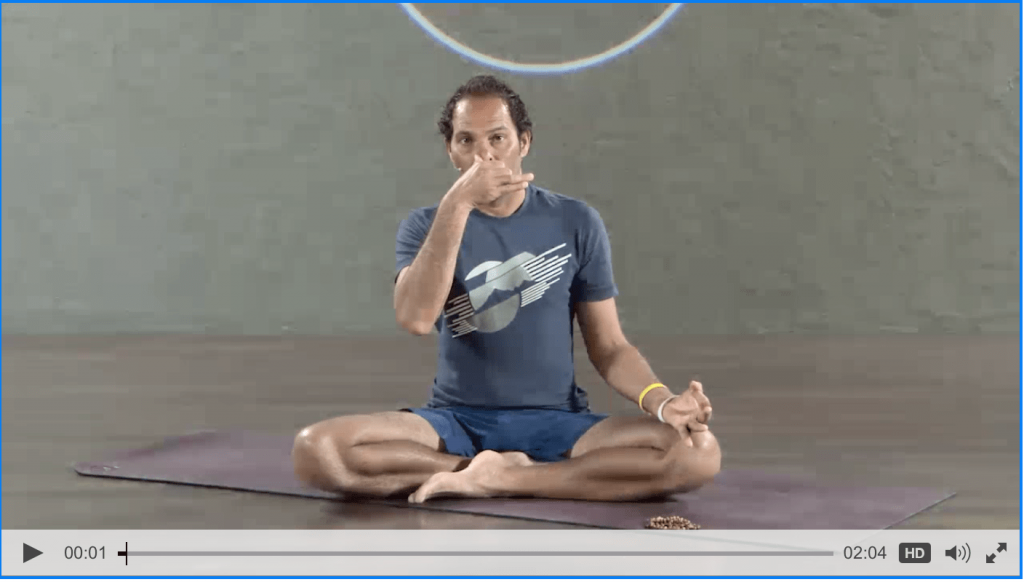There's a type of Yoga practice to treat your anxiety and relax called alternate-nostril breathing. Also known as Nadi Shodhana, this technique carries a larger supply of oxygen to the blood than regular breathing. It soothes your nerves, helps to still your mind, and balances the subtle energy of your body.
Sounds awesome, right? Now, you probably wonder how to do alternate-nostril breathing? How long you should practice Nadi Shodhana? How does this relaxation technique work biologically?
Today I'm going to share alternate nostril breathing instructions, to tame your mischievous, unpredictable, wild mind. Because if you're like most of us, you have what is known as “monkey mind,” a mind that chatters and is rarely still. Your thoughts keep chattering and jumping around all over the place, just like a monkey.
Benefits of Alternate Nostril Breathing: 
-
Calms the mind
-
Purifies the emotions
-
Balances and improves brain function
- Improves Sleep
- Cleanses the lungs
- Prepares you for meditation
Left nostril is for calming – right nostril is for energy
Your nose is directly linked to your nervous system and brain.
Breathing in through the left nostril will access the right side of your brain. This is the feminine, feeling, nurturing, calm, and cooling hemisphere of your brain.
Breathing in through the right nostril will access the left side of your brain. This is the masculine, thinking, competitive, active, heating hemisphere of your brain.
What's really cool is approximately every 90 minutes your breath pattern changes, alternating between breathing through the right nostril and then the left. When you consciously alternate your breath between nostrils you access and activate your whole brain.
Since your state of mind is reflected in the way you breathe, it makes sense that by controlling the breath you can learn to control your state of mind. Think about it… When you are angry or scared, your breathing is shallow, rapid and irregular; but when you are relaxed or deep in thought, your breathing becomes rhythmic and slow.
By regulating your breath, you not only increase your intake of oxygen, but you are preparing yourself for a grounded, stable mind.
Alternate nostril breathing triggers the parasympathetic nervous system. You can switch your nervous system from a stressed response to a relaxation response.
When you quiet the mind, all things are possible ~Meister Eckhart
Instructions: How To Do Alternate Nostril Breathing
Caution:
Alternate nostril breathing should not be practiced if you have a cold or if your nasal passages are blocked in any way. Under no circumstances should anything be forced.
Now, of course, you cannot really turn off your mind completely. Thoughts come and go and this is natural, but alternate nostril breathing can quiet your mind and restore ease to your body.
I'm also a huge fan of another calming ritual called Yoga Nidra, and use it often in the late afternoon to turn off my mind and tune into my heart, especially after a demanding day.
Yoga Nidra
Relaxation is a state best achieved by using a technique like Yoga Nidra that triggers it. During Yoga Nidra, the body relaxes and the mind follows. When the mind relaxes, the relaxation of the body is further deepened.
Yoga Nidra invites your innate wisdom to rise to the surface of your consciousness so you can tap into the wisdom of your heart. Any doubts you have about what you can do in life have no power in this state. When you are deeply relaxed, you can cooperate with your subconscious mind, which is open to the ideas you give it.
The aim of Yoga Nidra is to induce influence on your reality, experience profound relaxation, eliminate stress, solve interpersonal problems, and promote health.
Conclusion of Alternate Nostril Breathing Instruction
Promise me you won't hesitate to ask me questions in the comment area below. I'm here to help you and want nothing more for you to be the healthiest version of yourself possible. Let me know if you need anything and I'll be sure to get back within “hours” most of the time.

Don't forget to follow us on Pinterest. Thank you for your time and reading.
The information presented here is in no way meant to serve as medical advice. If you are experiencing symptoms of any kind, please consult with your physician.






This looks like a great exercise to do. Recently I have trouble sleeping at night and receive medication for it but I believe this is an healthier option . I didn’t know about this practice or about Yoga Nidra and your saying it exists for 5000 years? For the best results how many times a day should I perform the Alternate Nostril Breathing exercise?
Hi Dira, If you can’t sleep at night lay on your right hand side, gently close your right nostril with your right thumb and breath through your left nostril. This will activate your parasympathetic nervous system which will calm you down and slow your heart rate. Left nostril breathing is cooling and nourishing for your whole being.
Thanks Jackie!
A lot of times I have trouble with quieting the mind when I go from the computer to the bed to sleep. I need a technique to silence the thoughts filling my head. This sounds like a style of meditation, but my trouble is losing focus very easily. But I’ll remember this nostril breathing technique tonight when I go to bed and see if it helps.
Hi Kent,
Yes, It profoundly helps to settle, cool, calm and nourish an agitated mind and wired nervous system. Even after just a few minutes minutes you can feel and notice a distinct difference as to how you feel. Don’t just try it once though… keep at it till you can see the amazing results yourself.
This was very helpful, I’ve been subjected to a high stress environment for days and just trying this for a few minutes helped me feel relaxed, and focus on other things I could do (like grounding).
I also want to pass this on to a friend of mine who has frequent panic attacks.
Hi Samantha,
I’m so pleased the breathing exercise helped you. The breath is a bridge to the mind, so keep practicing and you will see extended results. Thank you for sharing the article with your friend.